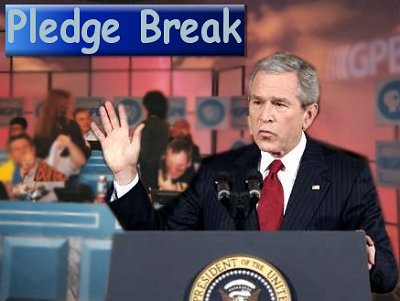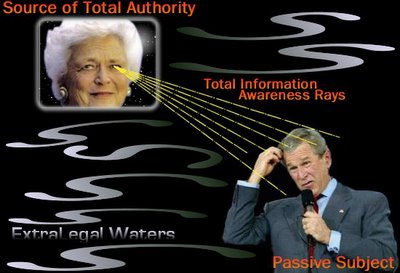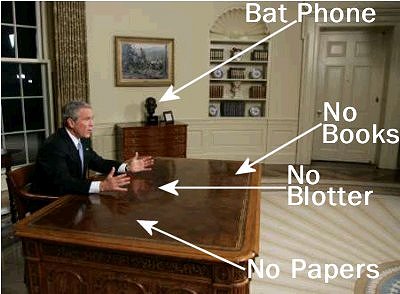Art Pottery, Politics and Food
Saturday, December 24, 2005

The Midnight Mass, Edward Timothy Hurley, 1911, Oil on Canvas
From the Collection of the Cincinnati Art Museum
Merry Christmas, everyone, and a Happy 2006!
Thursday, December 22, 2005

Within moments of stealing the Chair of St. Peter, Joe Ratzinger was embroiled in a major historical imbroglio.
The abuse scandals?
Women priests?
Gay marriage?
No.
The new pope's first crisis involved fashion.
It seems the aged effete had developed a parallel and once repressed taste for medieval papal clothing along with his 10th century moral philosophy.
This Newsweek article was one of a raft of "Pope wears Prada" stories published shortly after this past year's Papal Conclave when it was revealed that Ratzinger had dumped Annibale Gammarelli, papal tailor since 1792, for his own personal sequin-studded and designer accessory-packed couture.
How Christ-like!
Yesterday, beaming like a schoolgirl and appearing completely foolish, Ratzie preened and modeled a new Santa-like cappellus, called a camauro, similar to one once worn by pre-enlightenment pontiffs.
The world media snickered.
Photos: ANSA, AP
Tuesday, December 20, 2005

The last week or so of extremely heavy media use by the White House and the resultant minor, variable and seemingly positive opinion poll shifts for Mr. Bush prove an old PBS pledge break axiom learned when I began my television career at a PBS station in 1972.
The pledge break rule had two parts.
The first part said that money raised was directly proportional to the length of time spent, on the air, begging for it.
The second part said that recordings of telephones ringing, broadcast behind the voices of the on-camera people, would guarantee real paying callers.
These rules, to my then 17 year-old mind, seemed completely degrading to the unique individual souls my religion and personal sense of morality celebrated.
As phone callers, over the years, dutifully and depressingly reacted like cattle after a televised goad, I learned there were federal provisions, governing fairness, accuracy, equal opportunity and impartiality, that protected this gullible mass creature, representing the broadcast audience.
The fairness provisions vanished in 1987 when President Reagan vetoed congressional legislation that would have turned what had been FCC policy into Federal Law.
Actual Federal Law, Section 315 of the Communications Act of 1937, required stations to offer "equal opportunity" to subsets of the total audience.
Though watered-down considerably by FCC declaratory rulings that transformed Donahue, Sally Jesse Raphael and The Howard Stern Show into “bona fide” and 315-exempt news programs, Section 315 and the Fairness Doctrine had worked in tandem since the 1940’s to protect all viewers.
Broadcasting companies and early information technology movers hated the expense caused by these Federal protections on the public airwaves and worked for their elimination.
The abolition of Fairness was one of the first great successes of the nascent rightwing corporate/political echo chamber.
Reagan’s FCC chairman Mark Fowler, in the early cell phone/internet nick of time, had successfully changed broadcasters from “community trustees” into “marketplace participants” on the verdant and easily plucked fields of the gloriously illusory rightwing Free Market shibboleth.
But, unlike the policies and rules of governments, people are not so quick to change the stripes of their behaviors.
The fragile mass human creature I described earlier, now infinitely magnified, marketed and broadcast over cell and internet transmissions, is free to be fleeced and manipulated by marketplace beasts more toothsome and sly than a mere local public TV station needing 1972-era dollars.
The President’s modest, pre FISA-wiretap scandal poll bump merely reflects his recent monopolization of broadcast and cable frequencies on an almost daily basis.
Life as a PBA pledge break.
Play the ringing phone sound effect, sit back and watch the phone calls happen.
Happily, individual humans are often far more cynical and prudent than their, slightly since 1972, more sophisticated mass counterpart.
Modified Image: DACurrie.com, Reuters
Monday, December 19, 2005
Wiretap Photo Doodle

Talking Points Memo:
What is likely really at issue here is the nature of the technology being deployed -- both new technology and technology which in the nature of its method of collection turns upside down our normal ways of thinking about what constitutes a reasonable or permissible search.
Congressional TIA Report, 2003:
The Total Information Awareness program, now called the Terrorism Information Awareness (TIA) program is...a prototype system/ network...that will integrate advanced collaborative and decision support tools; language translation; and data search, pattern recognition, and privacy protection technologies.
Images: Google, Reuters
Sunday, December 18, 2005
"My decisions have led to terrible loss..."
--George W. Bush

I heard the bells on Christmas day
Their old familiar carols play,
And wild and sweet the words repeat
Of peace on earth, good will to men.
And thought how, as the day had come,
The belfries of all Christendom
Had rolled along the unbroken song
Of peace on earth, good will to men.
Till ringing, singing on its way
The world revolved from night to day,
A voice, a chime, a chant sublime
Of peace on earth, good will to men.
Then from each black, accursed mouth
The cannon thundered in the South,
And with the sound the carols drowned
Of peace on earth, good will to men.
It was as if an earthquake rent
The hearth-stones of a continent,
And made forlorn, the households born
Of peace on earth, good will to men.
And in despair I bowed my head
“There is no peace on earth,” I said,
“For hate is strong and mocks the song
Of peace on earth, good will to men.”
Then pealed the bells more loud and deep:
“God is not dead, nor doth He sleep;
The wrong shall fail, the right prevail
With peace on earth, good will to men.”
--Henry Wordsworth Longfellow, 1864
Photo: Reuters

